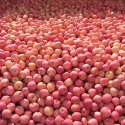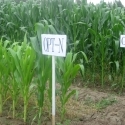23 Aug 2018
Potassium fertilization is critical to sunflower

Potassium (K) nutrition plays an especially important role for sunflower crops. The crop is very sensitive to soil K deficiency, and the lack of K often results in both low seed yields and oil concentrations. Sunflower plants have higher resistance to drought and salinity stresses when supplied with adequate K. Reduced stress typically allows for greater dry matter allocation during the seed-filling process …leading to higher yields. These responses to K are because of the nutrient’s prominent role in regulating many major physiological processes including:
1) establishment of osmotic gradients within plants that affect tissue hydration, cell growth, leaf expansion, and stomatal guard cell regulation;
2) activation of numerous enzymes that affect the metabolism of carbohydrates and protein;
3) promotion of photosynthesis;
4) transport of plant assimilates and metabolites; and
5) building of cellulose that promotes tolerance to pests and disease.
Field trials conducted on-farm in northwest China typically find that K fertilization significantly affects seed yield and quality. For sunflower grown for oil, more than 75% of trials have had good yield responses to K application. In sunflower crops grown for human consumption, 100% of trials have had significant yield responses to K. The data indicates that oil and edible sunflower seed yields would be expected to increase by 4 kg and 3 kg, respectively, for each kg K2O that is applied.
Improved sunflower product quality traits due to K fertilization include higher kernel oil concentrations for both sunflower grown for oil or human consumption, increased unsaturated fatty acid contents such as oleic and linoleic acids in oil sunflower seeds, and increased protein content in edible sunflower seeds (Table 1).
Farmers need to be aware of the significant relationships between total aboveground K and
seed yield for sunflower (Figure 1). Sunflower’s demand for K is twice its need for nitrogen (N).
For seed yields ranging between 3 to 4 t/ha, the amount of aboveground N, phosphorus (P), and K uptake that is needed to produce 1 t of seed is 42 kg N, 13 kg P, 91 kg K for oil sunflower, and 34 kg N, 5 kg P, 69 kg K for edible sunflower. In northwest China, average total nutrient accumulation by sunflower amounts to 172 kg N/ha, 53 kg P/ha, and 400 kg K/ha (for oil sunflower) and 139 kg N/ha, 25 kg P/ha, and 249 kg K/ha (for edible sunflower). Farmers in northwest China could only just be becoming aware of the important role that consistent crop residue recycling practices have on improving the K budget in the field. To compensate for any excessive K removal caused by crop harvest and a lack of straw recycling, about 300 to 400 kg K2O/ha is required for oil sunflower, and 200 to 300 kg K2O/ha is required for edible sunflower.
Table 1. Sunflower oil, fatty acid, and crude protein contents are affected by K fertilization
Oil content (%) | Saturated fatty acids (%) | Unsaturated fatty acid (%) | Oleic acid (%) | Linoleic acid (%) | Crude protein (%) | |
| Oil sunflower | ***1 | * | *** | *** | *** | ns |
| Edible suflower | *** | *** | *** | ns | ns | *** |
ns = no significant difference; * and *** = 95% and 99.9% probability of a significant difference.
Figure 1. Both oil and edible sunflower have a strong relationship between plant K uptake and seed yield.




